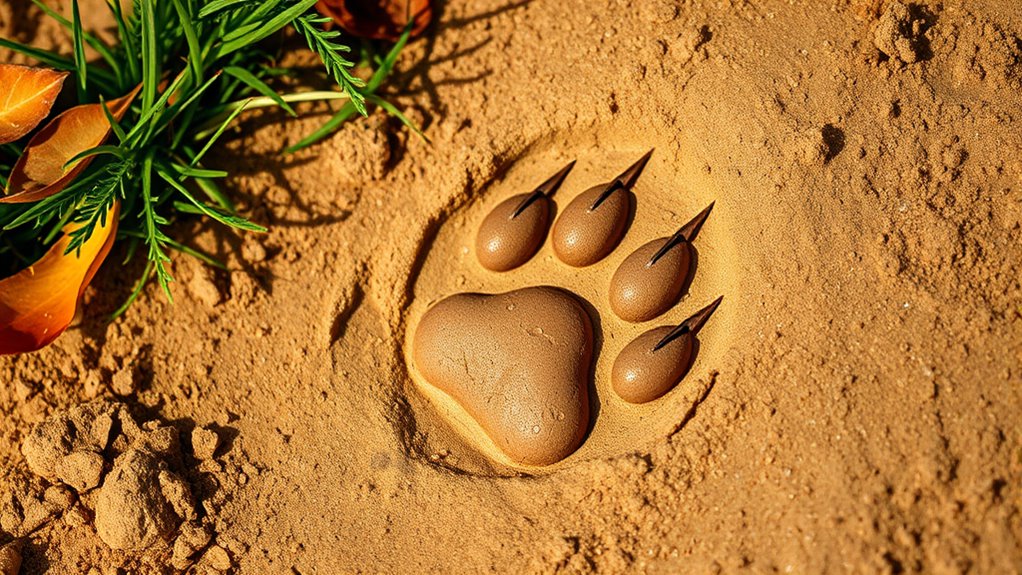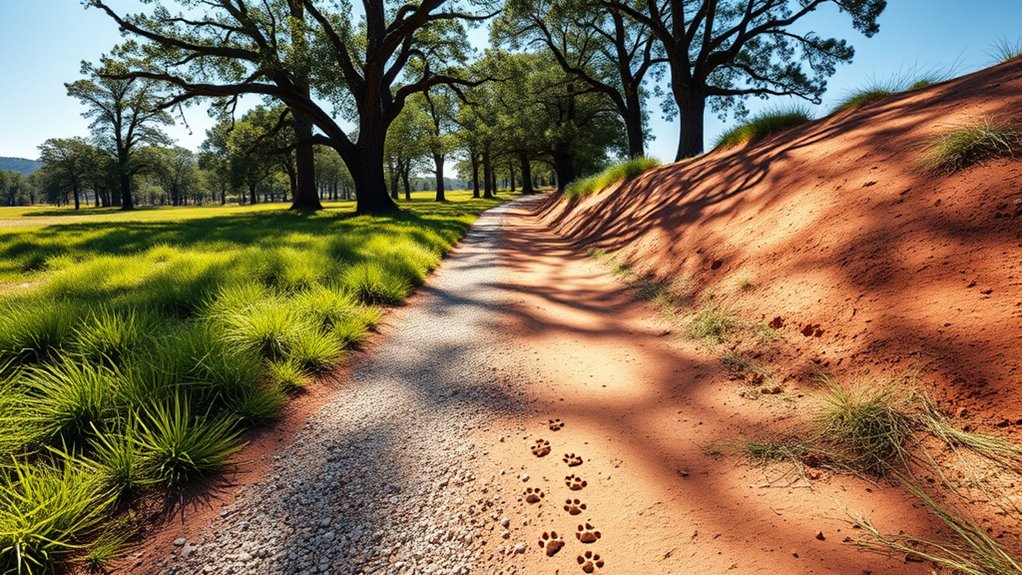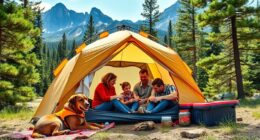When planning outdoor activities for older dogs, focus on flat, soft terrains like grassy fields or dirt trails that reduce joint strain and provide good footing. Avoid rocky, sandy, or steep paths that could cause injury or fatigue. Paved walkways with shade are ideal to keep your senior dog comfortable and cool. Pay attention to paw health and bring protective booties if needed. If you want tips on creating the safest routes, keep exploring to learn more.
Key Takeaways
- Prioritize flat, soft terrains like grassy fields or dirt trails to minimize joint strain for senior dogs.
- Avoid rocky, uneven, or steep terrains that increase risk of slips and joint stress.
- Use shaded, well-maintained paths to help regulate temperature and prevent overheating during outdoor activities.
- Incorporate level routes and paved pathways to ensure consistent footing and reduce paw injury risks.
- Regularly check paws and consider protective booties on rough surfaces to maintain paw health and safety.

Have you ever wondered how to turn your ideas into a clear, actionable plan? When it comes to outdoor activities with your senior dog, planning is essential to ensure their safety and enjoyment. One of the most important aspects is understanding terrain types that are best suited for older dogs. This knowledge helps you create a safe environment, minimize discomfort, and prevent injuries. Senior dog safety should always be your top priority, especially as their joints and paws become more vulnerable with age.
Start by choosing flat, soft terrains like grassy fields or dirt trails. These surfaces are gentle on your dog’s joints and paws, reducing the risk of soreness or cuts. Avoid rocky or uneven paths that can cause slipping or paw pad injuries. If you’re planning a walk or hike, stick to well-maintained paths that offer a smooth surface. This not only protects your dog physically but also makes outdoor activity tips easier to implement, such as keeping your senior dog on a leash and monitoring their pace.
Choose flat, soft terrains like grassy fields or dirt trails for safer senior dog walks.
When selecting outdoor spots, consider shaded areas or places with plenty of tree cover. Older dogs have a harder time regulating their body temperature, so avoiding direct sunlight helps prevent overheating. Bring water along and encourage frequent hydration breaks, especially during warmer months. Remember, your goal is to keep your senior dog comfortable and safe, so be attentive to signs of fatigue or overheating.
Another terrain type that works well for senior dogs is paved pathways, like park sidewalks or paved trails. These surfaces provide consistent footing, reducing the chance of slips and falls. However, they can be hard on paws over long distances, so check your dog’s paws regularly for signs of wear or discomfort. Consider using protective booties if you notice abrasions or if your dog has sensitive paws.
Avoid sandy or loose gravel terrains, as they can be difficult for older dogs to navigate and may cause paw soreness. Steer clear of steep inclines or rugged terrains that require intense exertion, as they can strain aging joints or cause fatigue. Instead, opt for gentle, level routes that allow your dog to enjoy outdoor activity without pushing their limits. Additionally, online resources can provide helpful information on suitable terrains and outdoor activity tips for senior dogs.
Frequently Asked Questions
What Safety Gear Is Recommended for Older Dogs on Rough Terrain?
When exploring rough terrain with your older dog, you should prioritize safety gear like dog booties to protect their paws from sharp or hot surfaces. Reflective vests are also essential for visibility, especially in low light or busy areas. These items help keep your senior dog safe, comfortable, and secure during outdoor adventures, allowing you both to enjoy the experience with peace of mind and added protection.
How Can I Tell if a Terrain Is Too Challenging for My Senior Dog?
To determine if a terrain is too challenging for your senior dog, do a thorough terrain assessment before heading out. Watch how well your dog navigates obstacles—if they struggle or show signs of fatigue, it’s a sign the terrain may be too demanding. Pay attention to their body language and pace, and adjust your route accordingly, ensuring their safety and comfort during obstacle navigation.
Are There Specific Training Tips for Older Dogs on Unfamiliar Terrains?
While exploring unfamiliar terrains, remember that training your older dog requires patience and consistency. Use positive reinforcement to build confidence, focusing on dog obedience and leash training to keep them safe. Juxtapose their age with their curiosity; this balance encourages gentle exploration. Start slow, praise often, and adjust based on their comfort. This approach guarantees your senior dog adapts smoothly, making every adventure enjoyable and secure.
How Can I Prevent Joint Strain During Outdoor Activities With Senior Dogs?
To prevent joint strain during outdoor activities with your senior dog, prioritize their comfort. Use joint supplements recommended by your vet to support joint health, and implement hydration strategies to keep them well-hydrated, which reduces strain. Avoid overly strenuous activities, and monitor their behavior closely. Regular rest breaks and gentle exercises can also help prevent joint discomfort, ensuring your dog stays active and happy without risking joint issues.
What Are the Signs of Fatigue or Discomfort in Older Dogs During Hikes?
You should watch for dog fatigue signs like heavy panting, slow movements, or reluctance to continue. Senior discomfort cues include whimpering, limping, or stiffness after activity. If you notice these signs during hikes, it’s vital to give your dog a break, provide water, and assess their condition. Recognizing these cues early helps prevent overexertion and keeps your older dog comfortable and safe during outdoor adventures.
Conclusion
As you start exploring terrain options for your older dog, you might find that the most suitable surfaces often appear when you least expect them—like a quiet park or a gentle trail during a routine walk. Sometimes, the best spots reveal themselves naturally, just like your dog’s unique needs. Trust those little moments of coincidence; they guide you to the perfect terrain, ensuring your loyal companion stays comfortable and happy on every adventure.










